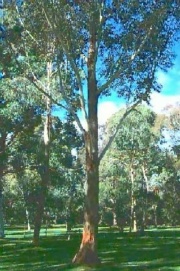Difference between revisions of "Blackbutt"
Jump to navigation
Jump to search
m (Text replace - "== Authority ==" to "== Sources Checked for Data in Record ==") |
|||
| Line 4: | Line 4: | ||
A eucalyptus tree, ''Eucalyptus pilularis'', native to Australia. Blackbutt trees produce a hardwood that is similar in appearance to oak. However, the wood can have a greasy feel and tends to warp and crack. Blackbutt timber is used for tool handles and small turned articles, but it is mainly cut commercially for its abundant oil. The pungent eucalyptus oil is used in pharmaceuticals, as an antiknock agent in gasoline and for the manufacture of menthol. | A eucalyptus tree, ''Eucalyptus pilularis'', native to Australia. Blackbutt trees produce a hardwood that is similar in appearance to oak. However, the wood can have a greasy feel and tends to warp and crack. Blackbutt timber is used for tool handles and small turned articles, but it is mainly cut commercially for its abundant oil. The pungent eucalyptus oil is used in pharmaceuticals, as an antiknock agent in gasoline and for the manufacture of menthol. | ||
| − | + | ==Physical and Chemical Properties== | |
| − | |||
| − | |||
| − | |||
| − | |||
| − | == | + | * Density = 40-50 ppcf |
| + | |||
| + | ==Resources and Citations== | ||
* G.S.Brady, ''Materials Handbook'', McGraw-Hill Book Co., New York, 1971 Comment: p. 382 | * G.S.Brady, ''Materials Handbook'', McGraw-Hill Book Co., New York, 1971 Comment: p. 382 | ||
Latest revision as of 15:39, 8 May 2022
Description
A eucalyptus tree, Eucalyptus pilularis, native to Australia. Blackbutt trees produce a hardwood that is similar in appearance to oak. However, the wood can have a greasy feel and tends to warp and crack. Blackbutt timber is used for tool handles and small turned articles, but it is mainly cut commercially for its abundant oil. The pungent eucalyptus oil is used in pharmaceuticals, as an antiknock agent in gasoline and for the manufacture of menthol.
Physical and Chemical Properties
- Density = 40-50 ppcf
Resources and Citations
- G.S.Brady, Materials Handbook, McGraw-Hill Book Co., New York, 1971 Comment: p. 382
- F. H. Titmuss, Commercial Timbers of the World, The Technical Press Ltd., London, 1965
